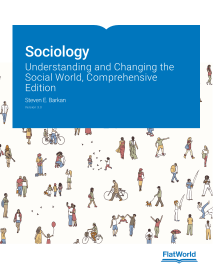Textbook Details

- By:
- Steven E. Barkan
- Published:
- January 2021
- Discipline:
- Sociology Textbooks
- ISBN (Digital):
- 978-1-4533-3539-0
Sociology: Understanding and Changing the Social World, Comprehensive Edition presents a sociological understanding of society while emphasizing the relevance of sociological knowledge and insights for changing society. It encourages students to make a positive difference in the world around them by developing their sociological imaginations
New in This Version
Chapter 1
2020 polling data, updated data on suicide, unemployment during the coronavirus pandemic
Chapter 2
Pandemic behavior and opinions; neighborhood influences on obesity; using age and COVID-19 to illustrate the difference between the independent variable and dependent variable
Chapter 3
Traditional cattle ritual in India and American individualism; COVID-19 behaviors
Chapter 4
Threats to a Muslim community center; watching television and the relationship between religiosity and belief in legal abortion; coverage of children’s well-being
Chapter 5
The first Black woman to play Batwoman; violating additional role expectations during the coronavirus pandemic; impression management and job interviewing
Chapter 6
Teenagers’ acts of racist vandalism; regional incarceration and the influence of social backgrounds for ending up in coercive organizations; groupthink and wearing face masks; gender and race/ethnicity in regards to imprisonment; new discussion of Black Lives Matter as an example of groups working for social change
Chapter 7
Robbery and the elderly; fear of crime; crime and victimization; new discussion of population density, crime rates, and COVID-19 rates
Chapter 8
Effects of the 2020 pandemic on low-income Americans; income and poverty data
Chapter 9
Effects of the 2020 pandemic on the world’s poor, global poverty and inequality; the consequences of the global pandemic for malnutrition
Chapter 10
Nationwide protests after police killing of George Floyd; the severe impact of the coronavirus pandemic on people of color; new racial and ethnic data throughout; mass media portrayal of people of color; racial bias in the treatment of African Americans with COVID-19 symptoms; the hidden toll of racial and ethnic inequality on the health, including evidence that the presidency of Donald Trump has impaired the health of people of color; how structural racism helps explain the higher COVID-19 infection and death rates for African Americans and Latinx
Chapter 11
Representative Alexandria Ocasio-Cortez and slurs about women; updated data on LGBTQ population; updated gender data; women’s traditional gender roles and the Bible; women’s caregiving responsibilities and the gender pay gap; new section on gender inequality amid the COVID-19 pandemic
Chapter 12
Senior citizens and volunteer work; data on aging; older Americans and social media during the pandemic; higher COVID-19 death rates for older Americans; nursing homes’ carelessness during the coronavirus pandemic; food security among older Americans; and reducing ageism and helping older Americans
Chapter 13
Effects of losing federal unemployment benefits; work and labor data; low-wage workers and the coronavirus pandemic; bloated military spending
Chapter 14
Voting and the coronavirus pandemic; updated voting and other political data
Chapter 15
Increased domestic violence because of the coronavirus pandemic; family data; parenting and childcare during the pandemic; cohabitation; effects of divorce on children; same-sex marriage; childcare and housework during the pandemic; increased intimate partner violence during the pandemic; dating violence in college and high school; child abuse and the pandemic
Chapter 16
Ventilation problems in public schools; education data; low-income secondary school students’ challenged during the coronavirus pandemic; racial/ethnic gap in educational attainment; comparisons to Finland; school choice; social class and race in college admissions; problems experienced by low-income college students during the pandemic
Chapter 17
Religious Americans’ beliefs about COVID-19; updated religion and religiosity data
Chapter 18
Disproportionate impact of COVID-19 on low-income people and people of color; health and health care data; annual household income and self-reported health; American diets and risk for COVID-19; racial/ethnic disparities in COVID-19 infections and deaths; the high cost of U.S. health care
Chapter 19
Shrinking cities; population data; the pandemic’s effects on birth and immigration rates; urban life as a risk factor for coronavirus infections; immigration; limiting traffic and pollution in Europe
Chapter 20
Climate change’s effects on infectious disease; environmental problems data; air pollution and the impact of the coronavirus pandemic; overall impacts of climate change
Chapter 21
Black Lives Matter protests
Brief Table of Contents
Part 1: Introducing Sociology
Chapter 1: Sociology and the Sociological Perspective
Chapter 2: Eye on Society: Doing Sociological Research
Part 2: The Basics of Social Life
Chapter 3: Culture
Chapter 4: Socialization
Chapter 5: Social Structure and Social Interaction
Chapter 6: Groups and Organizations
Chapter 7: Deviance, Crime, and Social Control
Part 3: Social Inequalities
Chapter 8: Social Stratification
Chapter 9: Global Stratification
Chapter 10: Race and Ethnicity
Chapter 11: Gender and Gender Inequality
Chapter 12: Aging and Older Adults
Part 4: Social Institutions
Chapter 13: Work and the Economy
Chapter 14: Politics and Government
Chapter 15: The Family
Chapter 16: Education
Chapter 17: Religion
Chapter 18: Health and Medicine
Part 5: Social Change
Chapter 19: Population and Urbanization
Chapter 20: Social Change and the Environment
Chapter 21: Collective Behavior and Social Movements
Chapter 22: Conclusion: Understanding and Changing the Social World
